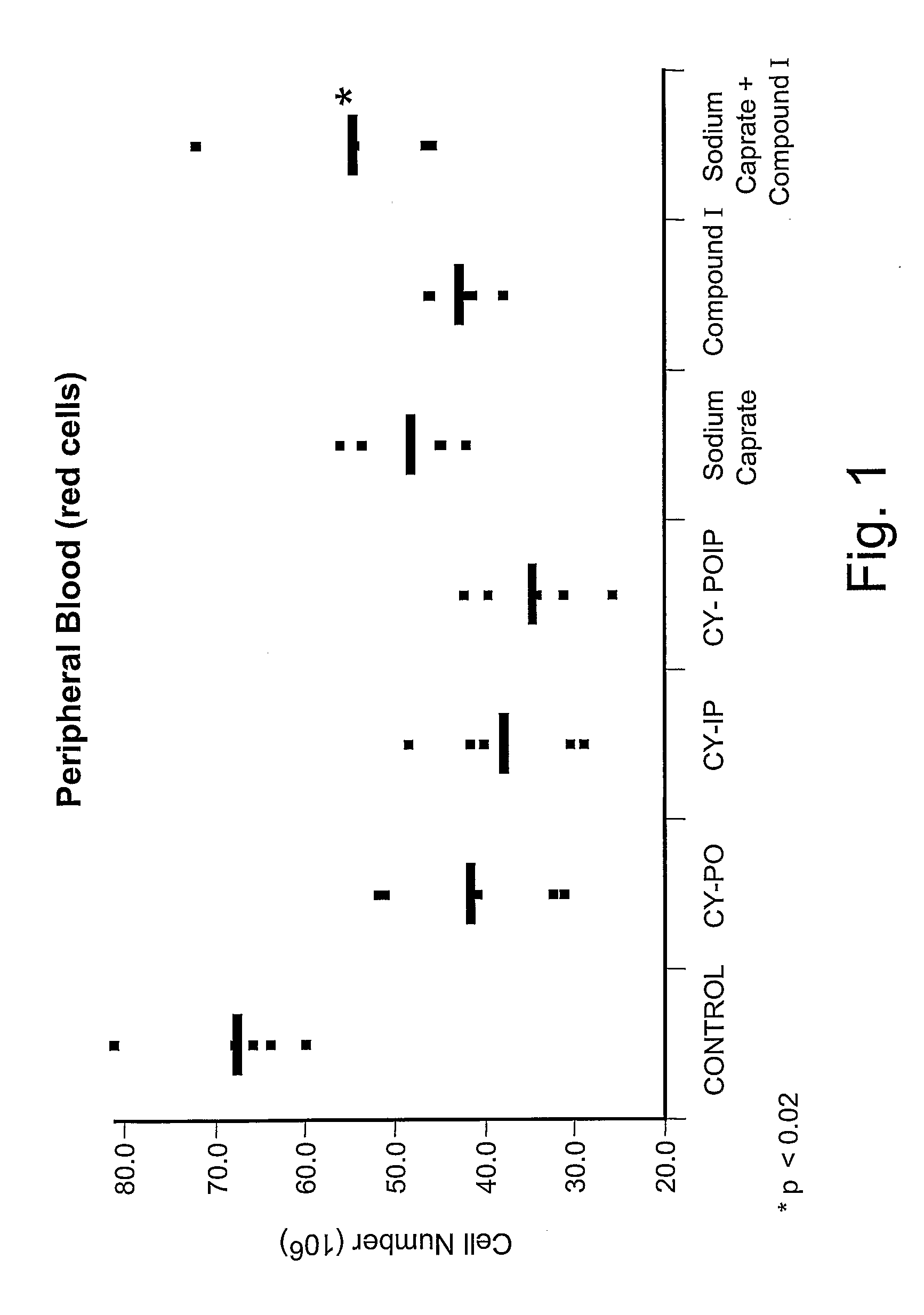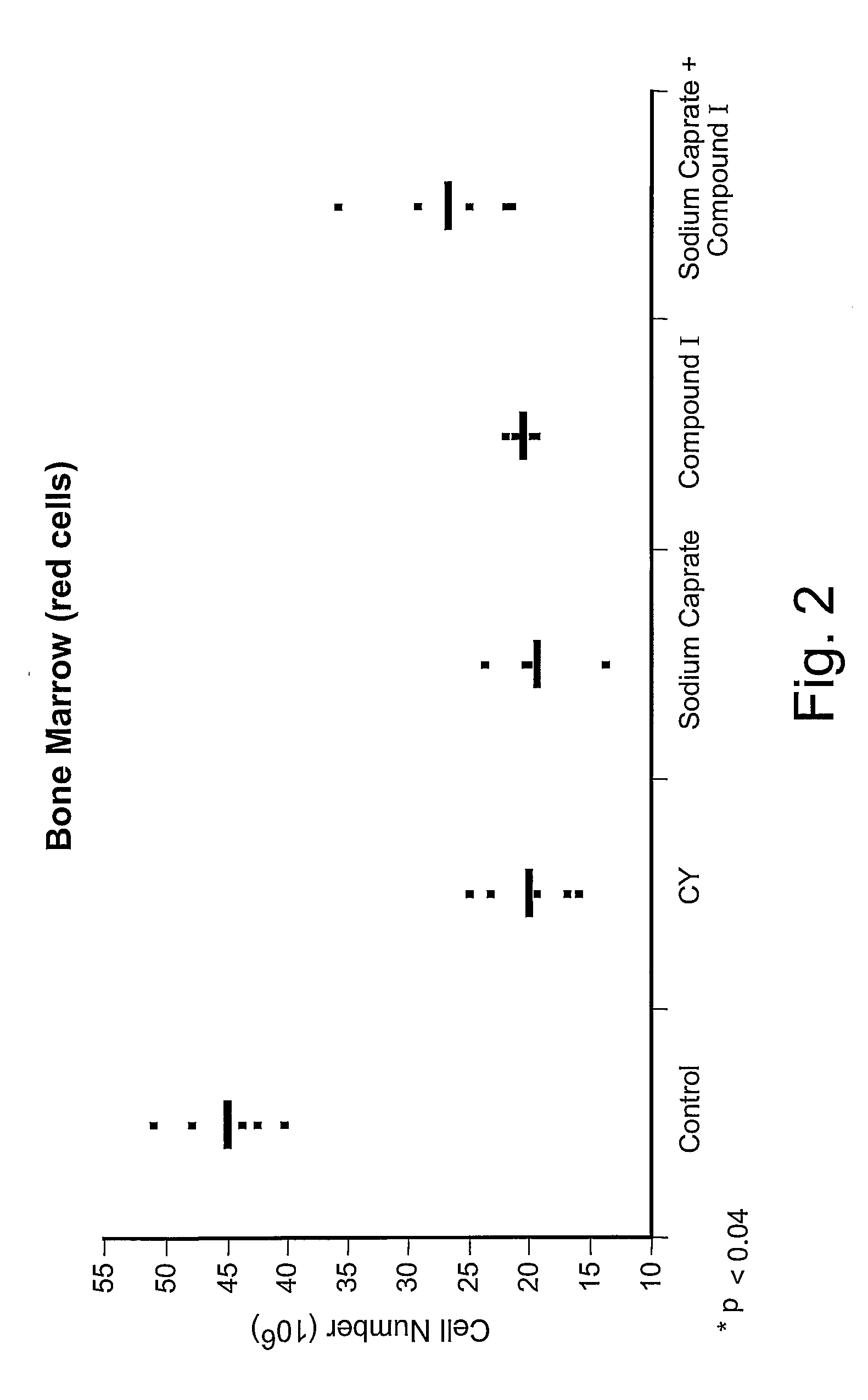Substituted Purinyl Derivatives With Immunomodulator And Chemoprotective Activity And Use Alone Or With Medium-Chain Length Fatty Acids Or Glycerides
a purinyl derivative and immunomodulator technology, applied in the direction of antinoxious agents, drug compositions, extracellular fluid disorders, etc., can solve the problems of rapid dividing cells, ionizing radiation is also toxic to normal, and patients undergoing chemotherapy and/or radiotherapy, etc., to achieve enhanced chemoprotective activity
- Summary
- Abstract
- Description
- Claims
- Application Information
AI Technical Summary
Benefits of technology
Problems solved by technology
Method used
Image
Examples
example 1
Chemoprotection studies: In Vivo Protection of Hematopoietic Cells by Compound I
[0038] Female C57BL / 6 mice, 6 to 8 weeks old, were immunosuppressed by treatment with 200 mg / kg of cyclophosphamide (CY) administered intravenously at day 0. To examine the chemoprotective effect of compound I, mice were pre-treated intraperitoneally at day −3, −2 and −1 with 50 mg / kg of the compound. Mice were sacrificed at day +5 by cardiac puncture and cervical dislocation. Then, cell suspensions were prepared from thymus, spleen and bone marrow as follows.
[0039] Tissues were crushed in PBS buffer and contaminating erythrocytes were lysed in ACK buffer (155 mM NH4Cl, 12 mM NaHCO3, 0.1 mM EDTA, pH 7.3) for five minutes. Cells were then collected by centrifugation and washed three times in PBS and resuspended in tissue culture medium. Cells were counted with a Coulter counter.
[0040] A significant increase in spleen red and white cell counts was observed after pre-treatment with compound I in CY-treat...
example 2
Chemoprotection studies: In Vivo Induction of Immune Cell Proliferation or Protection by the Combination of Sodium Caprate and Compound I
[0041] The effect of sodium caprate, compound I, and the combination of both compounds on in vivo induction of hematopoietic cell proliferation or protection was determined following the protocol described in Example 1. Oral administration of sodium caprate (60.5 mM) and / or peritoneal injection of compound I (50 mg / kg) were performed on day −3, −2 and −1. Treated animals were compared to their respective control groups: CY+sodium caprate was compared to CY-PO (CY+PBS per os); CY+compound I was compared to CY-IP (CY+PBS intraperitoneal injection); and CY+sodium caprate+compound I was compared to CY-POIP (CY+PBS per os and PBS by intraperitoneal injection).
[0042]FIG. 1 represents the effect of sodium caprate, compound I, and the combination of both compounds on peripheral red blood cell count. A significant increase of peripheral red blood cells wa...
example 3
Chemoprotection Studies: In Vivo Induction of Immune Cell Proliferation or Protection by the Combination of Tricaprin and Compound I
[0044] The effect of tricaprin, compound I, and the combination of both compounds on in vivo induction of hematopoietic cell proliferation or protection was determined following the protocol described in Example 1. Oral administration of tricaprin (60.5 mM) and / or peritoneal injection of compound I were performed on day −3, −2 and −1.
[0045] Table 2 represents the effect of tricaprin, compound I, and the combination of both compounds on bone marrow red cell count. A significant increase of bone marrow red cells was obtained by pre-treatment with a combination of tricaprin and compound I in CY-treated mice. This was a synergistic effect as compared to CY alone. Furthermore, mice treated with the combination of tricaprin and compound I demonstrated an increase (3 times) in CFU-GEMM cell population in bone marrow (Table 3).
TABLE 2Effect of tricaprin, co...
PUM
| Property | Measurement | Unit |
|---|---|---|
| pH | aaaaa | aaaaa |
| volume | aaaaa | aaaaa |
| white blood cells | aaaaa | aaaaa |
Abstract
Description
Claims
Application Information
 Login to View More
Login to View More - R&D
- Intellectual Property
- Life Sciences
- Materials
- Tech Scout
- Unparalleled Data Quality
- Higher Quality Content
- 60% Fewer Hallucinations
Browse by: Latest US Patents, China's latest patents, Technical Efficacy Thesaurus, Application Domain, Technology Topic, Popular Technical Reports.
© 2025 PatSnap. All rights reserved.Legal|Privacy policy|Modern Slavery Act Transparency Statement|Sitemap|About US| Contact US: help@patsnap.com



